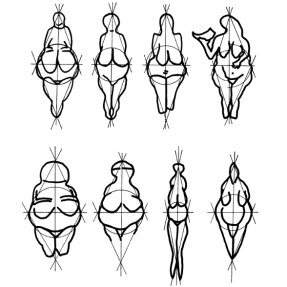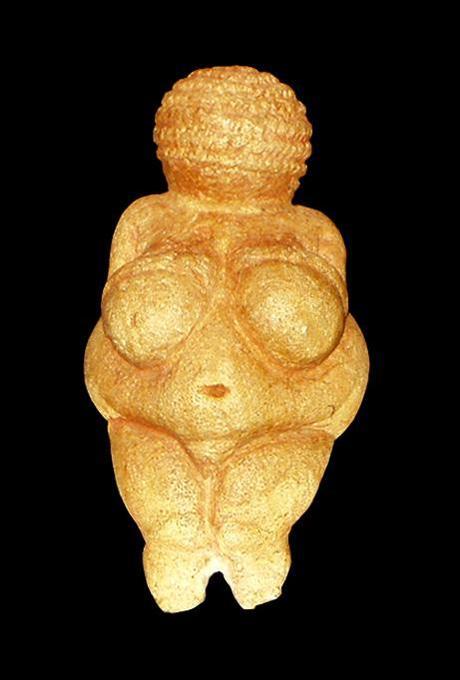Scientists recently discovered 39,000 year old cave art in Indonesia. This makes it older than most other stone age cave art, and located around 17,000 km away from Europe (where that other art is found). However, what makes this Indonesian art most interesting isn’t how old or how out of the way it is; but how similar it is to that European art despite those things. It uses a similar set of techniques to depict similar things1. Crazy eh?
Or maybe not. It turns out, cave art isn’t the only type of palaeolithic art to be so unusually similar: enter the Venus figurines.
What are the Venus figurines?
Great question, me. Lets start with the basics. The Venus figurines are a series of about 200 statuettes, about as big as your fist, made by prehistoric Europeans. The thing that makes them special (and relevant to the Indonesian art) is that they were created for a very long time over a very wide area. The first examples date to ~35,000 years ago (shortly after humans first arrived in the continent) and continued to be created right up until ~20,000 years ago2. And they’re found in France, although way across to Siberia. So they represent a degree of cultural consistency across 15,000 years and an awful lot of kilometers. Impressive right?
They’re also kinda notable because some of them are made from fired clay, representing the oldest known ceramics. However, most tend to be made out of ivory, bone or stone3.

A map of where Venus figurines made between 25 – 23 kya are found. Yes, this doesn’t include the entire time period, but it’s the best map I could find. The alternative is some abomination I concoct in Microsoft Paint. Be glad I didn’t go with that option.
If there’s so much variation why are they special?
Whilst the materials they might be made out of can be very different, what these figurines depict is always the same: women. Specifically, women with an exaggerated chest, stomach and hips but underxaggerated (?) head, legs and bum. In fact, the legs are so downplayed that they often just taper to a point, without any feet4.
Sure, they aren’t all identical; but despite being spread out across time and space they all depict the same thing in a very similar way. And that’s what makes them special.

Venus figurines from across Europe all share many similarities
So why were so many people making the same thing?
Well that’s the key question isn’t it. If we knew that it would help us understand an awful lot about the Venus figurines, as well as many other aspects of prehistoric art (like the similarities between the new Indonesian cave art and the stuff from other continents). However, whilst it would be great if we had the answer…we don’t. We do have a lot of ideas though, which I will now briefly summarise for you. Because I’m nice like that.
1. Fertility symbols

Such fertility. Much pregnancy.
This doesn’t really explain why so many people were making the same thing, but tries to identify why they picked chunky women in the first place. What if they were connected to fertility and pregnancy? After all, those are kind of important to the survival of a society. But the evidence for this doesn’t just end at “it makes sense”. Studies have examined the depiction of fat deposits on the figurines3 and the clothes2 and both seem to be accurate. Sure, the statues might contain exaggerated features, but they were based on something real to begin with.
So why the exaggeration? The obvious answer is that the bits which are emphasised are those associated with childbirth and childrearing. Hence the “fertility symbol” idea. However, one researcher has an alternate view. Imagine you’re a pregnant women. Look down. The bits which are closer to you (and so would appear larger) are also the bits which are larger on the figurine. On the other hand, your feet are far away and small and hard to see. Those are the bits which are downplayed on the figurine. Based on all of this he concluded that these are self portraits by pregnant women, looking down and chisling a statue of what they see5.
2. Historical relic
When humans first arrived in Europe they came as one group, which spread across the whole continent. Over time this began to fracture into regional populations, but for a brief period everyone in Europe seems to have belonged to the same “tribe”. The evidence for this comes from their toolkit. The first Europeans used one collection of technology that soon spread across the continent, before accumulating regional variation and fracturing. Could it be that this original “tribe” made Venus figurines, and later Europeans inherited it from them, thus explaining why it is so widespread?

The spread of the Aurignacian
I quite like this idea, although it doesn’t seem to completely add up. Mostly because the first Venus figurines don’t appear until well after the Aurignacian first arrived, suggesting they aren’t part of the same cultural heritage4.
3. VENUS FRIEND
I might like the previous explanation, but I think this is perhaps the most popular idea overall. So popular I’ve discussed it before, so if you’d like to know more click over there. I’ll just be brief here.
The Venus friend hypothesis is simply that the first Europeans had a tough time. They needed friends they could ask for help from when times got tough. The figurines represent a way of solidifying that friendship. Perhaps they served as a sort of “token” that could be cashed in with another group for favours. Or maybe you gave it to your friends as a way of identifying them later. “Oh he has our tribes Venus, he can be trusted.” After all, it might be generations before you need to call upon those friends, so having a tangible way to keep track of them could be helpful6.
4. Coincidence
There’s a few ideas which can’t be disproven, but aren’t given much credence either. What if it was coincidence? What if it’s just prehistoric porn? And so forth. Feel free to add your own silly suggestions to this list in the comments.
So what does it all mean?
Stone age people were far from isolated, primitive people. Somehow ideas were spreading across the entire continent in the form of figurines. Whether it was a way to symbolise alliances or a historical artefact, it’s clear that prehistoric life was a lot more complicated and interconnected than many thought. The new Indonesian art seems to suggest we need to re-evaluate this again. Was there once a community that stretched across continents? Were Europeans forming alliances or trading with people from other continents? Whatever the answer is, it will be fascinating.
References
- Aubert, M., Brumm, A., Ramli, M., Sutikna, T., Saptomo, E. W., Hakim, B., … & Dosseto, A. (2014). Pleistocene cave art from Sulawesi, Indonesia. Nature,514(7521), 223-227
- Soffer, O., Adovasio, J. M., & Hyland, D. C. (2000). The “Venus” figurines.Current Anthropology, 41(4), 511-537.
- Dixson, A. F., & Dixson, B. J. (2012). Venus Figurines of the European Paleolithic: Symbols of Fertility or Attractiveness?. Journal of Anthropology,2011.
- Gamble, C. (1982). Interaction and alliance in Palaeolithic society. Man, 92-107.
- McDermott, L. (1996). Self-representation in Upper Paleolithic female figurines.Current Anthropology, 227-275.

